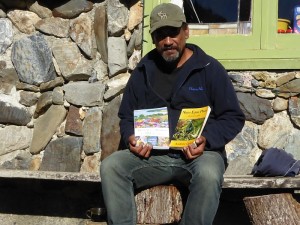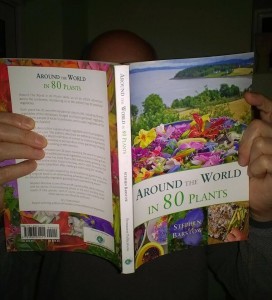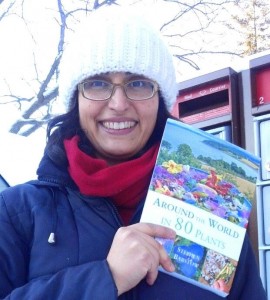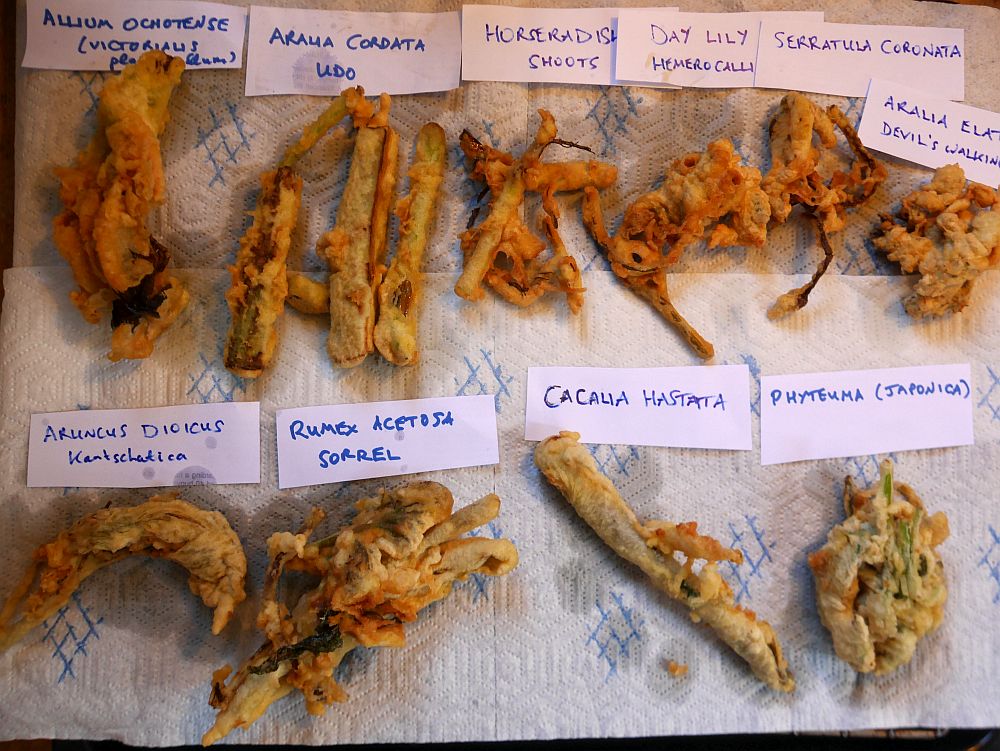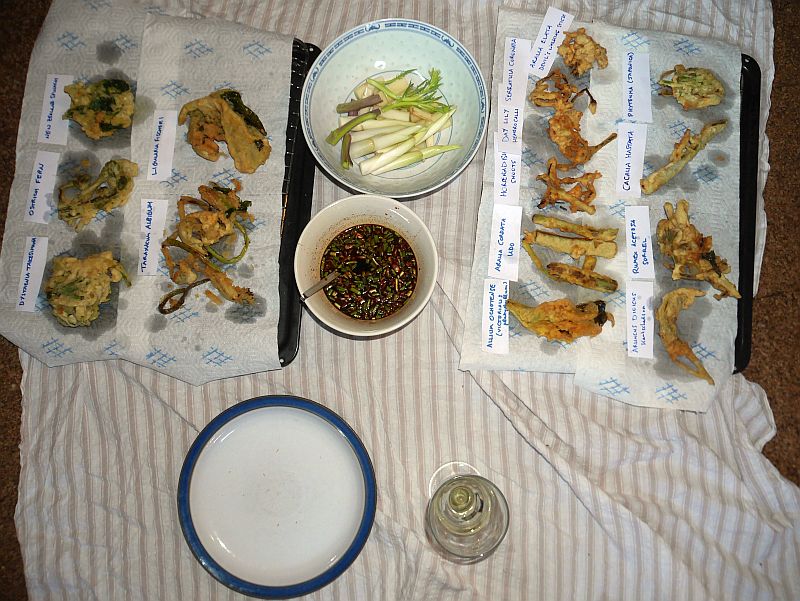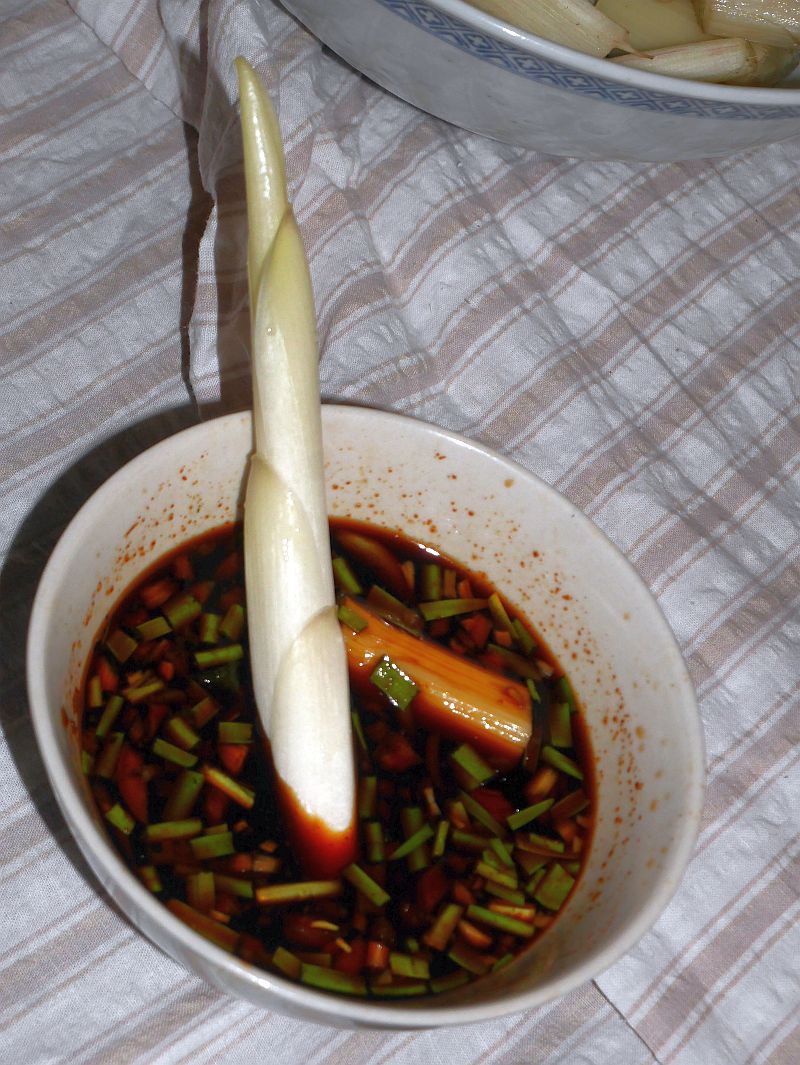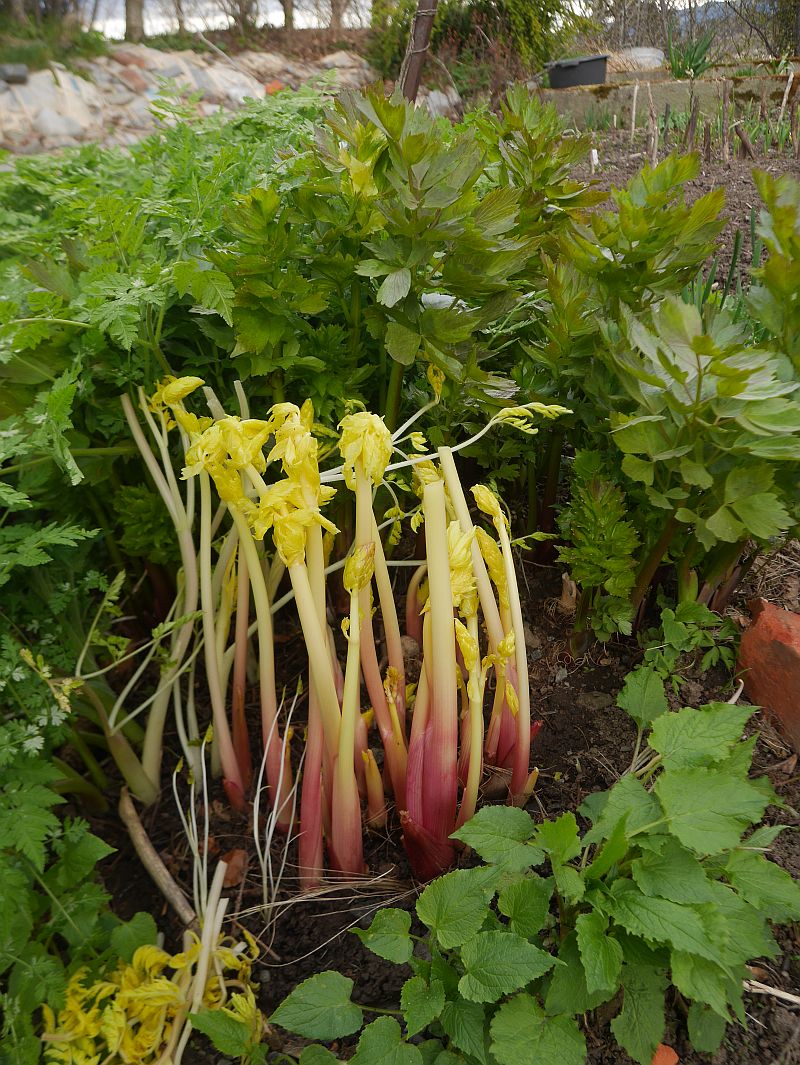When giving talks I like to renew myself and talk about something different each time. For my talk in Copenhagen at the Future Heirloom event last weekend I focussed during part of my presentation on edimentals in the Asteraceae or Compositae (the aster or daisy family / kurvplantefamilien). These are tbe edible perennial vegetables that are most obvious in the autumn garden and often underutilised by chefs in the west. Visiting the World Garden a few days before my talk on 17th October, I gathered flowers from all the flowering Asteraceae and here they are with names: Most are used for their tasty spring shoots and leaves, used cooked and raw, and most have a characteristic fragrant taste / aroma loved in the Far East (as also Chrysanthemum tea is popular and a refreshing accompaniment to spicy dishes). Aster scaber and Ligularia fischeri are nowadays both cultivated in a big way as “sannamul” in Korea and even exported to Korean markets around the world. Young shoots of other Aster sp. are foraged in Asia as is big-leaf Aster, Aster macrophyllus, in North America. Also from North America, cutleaf coneflower Rudbeckia laciniata or sochan was a popular vegetable for the Cherokee first people and in recent years has, maybe not unsurprisingly become a commercial vegetable in Korea. Annual shungiku or chopsuey greens Glebionis coronaria hails from the Mediterranean but is today an important vegetable in the Far East! Others currently in flower are best known as root crops, including (in the picture) Jerusalem artichoke (Helianthus tuberosus) and Dahlia. Yacon (Polymnia sonchifolia) is also autumn flowering but doesn’t manage to flower here (is moved indoors to flower and bulk up). The final flower in the picture is marigold Calendula officinalis, whose culinary use includes decorating and flavouring salads, soups and other dishes.
Most are used for their tasty spring shoots and leaves, used cooked and raw, and most have a characteristic fragrant taste / aroma loved in the Far East (as also Chrysanthemum tea is popular and a refreshing accompaniment to spicy dishes). Aster scaber and Ligularia fischeri are nowadays both cultivated in a big way as “sannamul” in Korea and even exported to Korean markets around the world. Young shoots of other Aster sp. are foraged in Asia as is big-leaf Aster, Aster macrophyllus, in North America. Also from North America, cutleaf coneflower Rudbeckia laciniata or sochan was a popular vegetable for the Cherokee first people and in recent years has, maybe not unsurprisingly become a commercial vegetable in Korea. Annual shungiku or chopsuey greens Glebionis coronaria hails from the Mediterranean but is today an important vegetable in the Far East! Others currently in flower are best known as root crops, including (in the picture) Jerusalem artichoke (Helianthus tuberosus) and Dahlia. Yacon (Polymnia sonchifolia) is also autumn flowering but doesn’t manage to flower here (is moved indoors to flower and bulk up). The final flower in the picture is marigold Calendula officinalis, whose culinary use includes decorating and flavouring salads, soups and other dishes.
Late flowering also means that the Asteraceae are also particularly important for a range of insect pollinators like hoverflies, drone flies and bees as can be seen in the pictures below, all taken in the World Garden:
Tag Archives: Ligularia fischeri
Doggy bag leaves
My daughter came over for lunch yesterday and couldn’t eat it all! Could I have a doggy bag she asked…preferably not plastic! Hosta sieboldiana “August Moon” and Ligularia fischeri leaves foraged some 5m from where we were sat did the job nicely :)

Korean tempura and dipping sauce for perennial vegetables
AROUND THE WORLD IN THE EDIBLE GARDEN; Part 2 – Korea
Inviting you to the second in a series of dinners from Malvik’s Edible Garden where we “forage” from different parts of the world!
We don’t often eat oily food, but now and again its great and this meal was exceptional!
From top left and clockwise:
Ligularia fischeri
Dystaenia takesimana (Giant Ulleung celery, seombadi)
Aralia cordata (udo) (blanched for dipping and green for tempura)
Phyteuma (should have been japonica, but I used nigra; svartvadderot)
Allium victorialis subsp platyphyllum (victory onion; seiersløk)
Aralia elata (devil’s walking stick, fandens spaserstokk)
Hosta “Frances Williams”
Hemerocallis dumortieri (flower shoots) (dayliliy, daglilje)
Parasenecio hastatus (also the first time I ate this one and it was delicious, but I wouldn’t advise eating a lot: see here http://www.edimentals.com/blog/?p=23845)
Matteuccia struthiopteris “Jumbo” (ostrich fern; strutseving)
Taraxacum albidum and to the right of this:
New Zealand spinach and
Serratula coronata (also a first for me; the subspecies insularis is eaten in the Far East)
Oplopanax horridus (North American species substituting Asian species Oplopanax japonicus or Oplopanax elatus)
More information with the pictures!
Pizza greens 1st May 2020
Presenting yesterdays greens used on a veggie 100% whole grain barley/spelt/rye sourdough pizza were:
Hablitzia tamnoides (Caucasian spinach /stjernemelde) (eaten now every day since the beginning of March and there’s more to harvest now than at any time since I started!)
Crambe maritima (sea kale / strandkål)
Allium ursinum (ramsons / ramsløk)
Levisticum officinale (lovage / løpstikke) (I call blanched lovage “spring celery” as it’s not that much stronger than celery…and much easier to grow than celery organically)
Ligularia fischeri (Gomchwi; Fischer’s Ligularia / Koreansk nøkketunge) (King of the Sannamul: see http://www.edimentals.com/blog/?page_id=3114)
Rumex patientia (Patience dock / Hagesyre)
Bistorta officinalis (Bistort / Ormerot)
Never before pizza?


Day 4 of the Permaveggies course and Ligularia wraps!







Perennial vegetable tempura
See also https://saladdy.wordpress.com/2014/04/25/tempura-day
..includes ostrich fern, blanched lovage, Udo, perennial kale, moss-leaved dandelion, Allium victorialis, nettles, Aster scaber, scorzonera shoots, Campanula latifolia, Oca, Myrrhis, Allium scorodoprasum, garlic, Allium ursinum, Ligularia fischeri (first time), sea kale, Primula veris “Red Strain”, Rumex acetosa, Alliaria petiolata and a few others…
#ATWselfie
The ATW selfie is going viral worldwide…. ;) Send me yours and it will be added…you will be showing support of a very good cause: the conservation and promotion of the amazing diversity of food plants Around the World!


One of my first interns, Daina Binde from Latvia, helped out in my garden in Malvik in 2014. She sent me this series of pictures this week of little Andris learning about perennial vegetables :) She is nowadays giving zoom lectures on permaculture and perennial vegetables!

I met Isaac Coblentz at Mountain Gardens (Joe Hollis’ place) – https://www.edimentals.com/blog/?p=26460. Isaac wrote to me: “This is one of my favorite books. I keep it in my backpack and never tire of re-reading. Your book has also expanded my diet and improved my health. It is a real treasure. It was so nice to meet you and spend time with you and Joe Hollis at Mountain Gardens”. He lives and gardens in Ashtabula, Ohio.

Presenting Norwegian forager and teacher Fru Johnsen of https://www.frujohnsenssoppognyttevekster.com. Cathrine is known as TanteGrusom (Aunty Cruel) on FB. I had a memorable visit from her and partner Edvin last summer: https://www.edimentals.com/blog/?p=23045.















